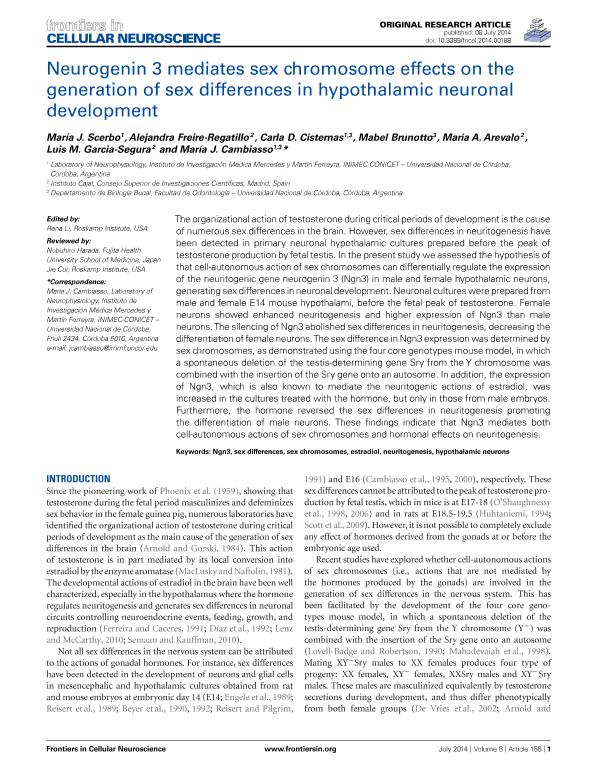Mostrar el registro sencillo del ítem
dc.contributor.author
Scerbo Jaureguiberry, Maria Julia

dc.contributor.author
Freire Regatillo, Alejandra
dc.contributor.author
Cisternas, Carla Daniela

dc.contributor.author
Brunotto, Mabel Noemí

dc.contributor.author
Arevalo, Maria Angeles
dc.contributor.author
Garcia Segura, Luis Miguel

dc.contributor.author
Cambiasso, Maria Julia

dc.date.available
2023-01-25T20:57:43Z
dc.date.issued
2014-07
dc.identifier.citation
Scerbo Jaureguiberry, Maria Julia; Freire Regatillo, Alejandra; Cisternas, Carla Daniela; Brunotto, Mabel Noemí; Arevalo, Maria Angeles; et al.; Neurogenin 3 mediates sex chromosome effects on the generation of sex differences in hypothalamic neuronal development; Frontiers Research Foundation; Frontiers in Cellular Neuroscience; 8; 188; 7-2014; 1-13
dc.identifier.issn
1662-5102
dc.identifier.uri
http://hdl.handle.net/11336/185625
dc.description.abstract
The organizational action of testosterone during critical periods of development is the cause of numerous sex differences in the brain. However, sex differences in neuritogenesis have been detected in primary neuronal hypothalamic cultures prepared before the peak of testosterone production by fetal testis. In the present study we assessed the hypothesis of that cell-autonomous action of sex chromosomes can differentially regulate the expression of the neuritogenic gene neurogenin 3 (Ngn3) in male and female hypothalamic neurons, generating sex differences in neuronal development. Neuronal cultures were prepared from male and female E14 mouse hypothalami, before the fetal peak of testosterone. Female neurons showed enhanced neuritogenesis and higher expression of Ngn3 than male neurons. The silencing of Ngn3 abolished sex differences in neuritogenesis, decreasing the differentiation of female neurons.The sex difference in Ngn3 expression was determined by sex chromosomes, as demonstrated using the four core genotypes mouse model, in which a spontaneous deletion of the testis-determining gene Sry from theY chromosome was combined with the insertion of the Sry gene onto an autosome. In addition, the expression of Ngn3, which is also known to mediate the neuritogenic actions of estradiol, was increased in the cultures treated with the hormone, but only in those from male embryos. Furthermore, the hormone reversed the sex differences in neuritogenesis promoting the differentiation of male neurons. These findings indicate that Ngn3 mediates both cell-autonomous actions of sex chromosomes and hormonal effects on neuritogenesis.
dc.format
application/pdf
dc.language.iso
eng
dc.publisher
Frontiers Research Foundation

dc.rights
info:eu-repo/semantics/openAccess
dc.rights.uri
https://creativecommons.org/licenses/by/2.5/ar/
dc.subject
ESTRADIOL
dc.subject
HYPOTHALAMIC NEURONS
dc.subject
NEURITOGENESIS
dc.subject
NGN3
dc.subject
SEX CHROMOSOMES
dc.subject
SEX DIFFERENCES
dc.subject.classification
Bioquímica y Biología Molecular

dc.subject.classification
Ciencias Biológicas

dc.subject.classification
CIENCIAS NATURALES Y EXACTAS

dc.title
Neurogenin 3 mediates sex chromosome effects on the generation of sex differences in hypothalamic neuronal development
dc.type
info:eu-repo/semantics/article
dc.type
info:ar-repo/semantics/artículo
dc.type
info:eu-repo/semantics/publishedVersion
dc.date.updated
2023-01-19T11:24:02Z
dc.journal.volume
8
dc.journal.number
188
dc.journal.pagination
1-13
dc.journal.pais
Suiza

dc.journal.ciudad
Lausana
dc.description.fil
Fil: Scerbo Jaureguiberry, Maria Julia. Consejo Nacional de Investigaciones Científicas y Técnicas. Centro Científico Tecnológico Conicet - Córdoba. Instituto de Investigación Médica Mercedes y Martín Ferreyra. Universidad Nacional de Córdoba. Instituto de Investigación Médica Mercedes y Martín Ferreyra; Argentina
dc.description.fil
Fil: Freire Regatillo, Alejandra. Instituto Cajal; España. Consejo Superior de Investigaciones Científicas; España
dc.description.fil
Fil: Cisternas, Carla Daniela. Universidad Nacional de Cordoba. Facultad de Odontologia. Departamento de Biologia Bucal; Argentina. Consejo Nacional de Investigaciones Científicas y Técnicas. Centro Científico Tecnológico Conicet - Córdoba. Instituto de Investigación Médica Mercedes y Martín Ferreyra. Universidad Nacional de Córdoba. Instituto de Investigación Médica Mercedes y Martín Ferreyra; Argentina
dc.description.fil
Fil: Brunotto, Mabel Noemí. Universidad Nacional de Cordoba. Facultad de Odontologia. Departamento de Biologia Bucal; Argentina
dc.description.fil
Fil: Arevalo, Maria Angeles. Instituto Cajal; España. Consejo Superior de Investigaciones Científicas; España
dc.description.fil
Fil: Garcia Segura, Luis Miguel. Instituto Cajal; España. Consejo Superior de Investigaciones Científicas; España
dc.description.fil
Fil: Cambiasso, Maria Julia. Universidad Nacional de Cordoba. Facultad de Odontologia. Departamento de Biologia Bucal; Argentina. Consejo Nacional de Investigaciones Científicas y Técnicas. Centro Científico Tecnológico Conicet - Córdoba. Instituto de Investigación Médica Mercedes y Martín Ferreyra. Universidad Nacional de Córdoba. Instituto de Investigación Médica Mercedes y Martín Ferreyra; Argentina
dc.journal.title
Frontiers in Cellular Neuroscience
dc.relation.alternativeid
info:eu-repo/semantics/altIdentifier/url/https://www.frontiersin.org/articles/10.3389/fncel.2014.00188/full
dc.relation.alternativeid
info:eu-repo/semantics/altIdentifier/doi/http://dx.doi.org/10.3389/fncel.2014.00188
Archivos asociados
